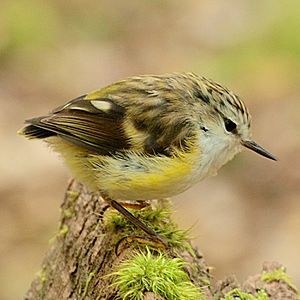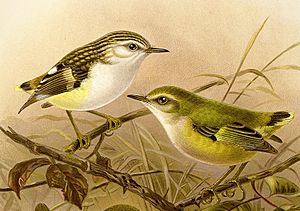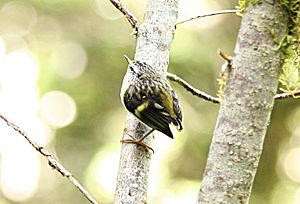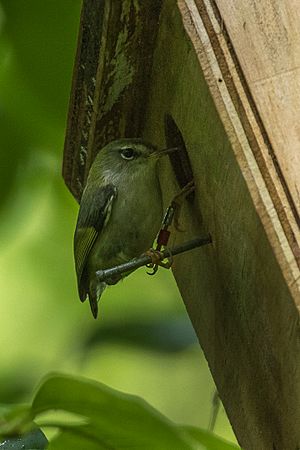Rifleman (bird) facts for kids
Quick facts for kids Rifleman (bird) |
|
|---|---|
 |
|
| Female | |
| Conservation status | |
| Scientific classification | |
| Subspecies | |
|
|
 |
The rifleman (also called titipounamu in Māori) is a tiny bird from New Zealand. It's an insectivore, meaning it eats insects. This bird is special because it's only found in New Zealand! It's part of a bird family called Acanthisittidae, and it's one of only two types of New Zealand wrens still alive today. Even though it looks a bit like other wrens, it's not closely related to the wrens you might find in other parts of the world.
Contents
About the Rifleman's Name
The rifleman was first described in 1787 by a scientist named Anders Sparrman. He found the bird in Queen Charlotte Sound in New Zealand.
The bird got its name, "rifleman," because its feathers looked similar to the uniforms worn by a New Zealand army group called the riflemen.
What Does a Rifleman Look Like?
The rifleman is the smallest bird that lives only in New Zealand. Adult birds are usually about 7 to 9 centimeters (3 to 3.5 inches) long. Male riflemen weigh around 6 grams, while females are a bit heavier at 7 grams.
Male riflemen are bright green on their backs with a yellow-green bottom. Their wings are black, green, and white, with a yellow stripe. Their tails are black with a white tip. Their chests and bellies are white, sometimes with a yellow hint.
Female riflemen are more brownish and have ochre (yellowish-brown) flecks on their heads and backs. Both male and female birds have white stripes above their eyes. They have short, rounded wings and a very short tail. Their thin, slightly curved beaks are perfect for finding insects in small cracks. When a rifleman flies, its quick wing beats make a humming sound, a bit like a hummingbird.
Rifleman Sounds and Calls
Riflemen make simple, high-pitched sounds. Their most common call is a squeaky, repeated "zipt." Some of their calls are so high-pitched that they might be in the ultrasonic range, which humans can't hear. Scientists are still learning why they make these sounds.
Where Do Riflemen Live?
Riflemen prefer to live in forests with thin trees. You might also find other similar New Zealand birds near rocky areas.
The rifleman is the most common type of New Zealand wren found on the North and South Islands. However, they are rare in the very northern parts of the North Island. The rifleman has two main groups, or subspecies:
- The North Island group, called A. c. granti, mostly lives in lowland tawa forests.
- The South Island group, A. c. chloris, lives in high-up beech forests or lowland podocarp forests.
A pair of riflemen will defend their territory every day. They can only fly short distances, so they usually don't cross open areas. These birds used to be common all over New Zealand. But as forests have been cleared for land development, their homes have become smaller and more separated.
Rifleman Behavior and Life Cycle
Building Nests and Reproduction
Both the male and female rifleman work together to build their nest. The nest is shaped like a dome or an oval. It's made from finely woven grass, soft feathers, and other light materials. The entrance to the nest is a small tunnel on the side, often so narrow that the bird has to squeeze to get in. Riflemen build their nests in holes in tree trunks, on branches, or even in holes in the ground.
Before the female lays eggs, the male often brings her food. This is an important part of their breeding process. He might bring her up to 42% of the food he collects!
A female rifleman usually lays two to five eggs. Both parents take turns sitting on the eggs to keep them warm for about 19 to 21 days. Once the chicks hatch, both parents feed them. Sometimes, young birds from earlier broods (families) will help their parents feed the new chicks. The chicks leave the nest after 21 to 27 days and can take care of themselves after four to six weeks. Riflemen often have two groups of chicks each year. They are happy to nest in special bird boxes, which helps more of their chicks survive.
How Riflemen Find Food
Riflemen are insectivores, so they eat insects. They look for small insects and maggots on tree trunks and among the leaves on the forest floor. They search for food in a special way, similar to a treecreeper. The bird starts at the bottom of a tree and slowly climbs up, circling around the trunk as it goes. Once it has searched one tree, it glides down to the bottom of a nearby tree and starts its search again.
See also
 In Spanish: Acantisita verdoso para niños
In Spanish: Acantisita verdoso para niños





